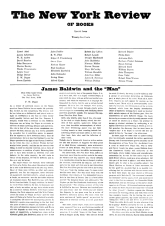The “non-book” has been a successful commodity for a long time. It now appears to have become a genre as well. The class of non-books includes the whole range of coloring books, photographs of infants, animals, or Famous Paintings being forced to say things by means of captions or balloons, the doctored news photographs, etc. Picture prevails over text in the non-book, and yet the result is not a book of pictures. It may have originated in the bound volumes of cartoonists’ work and the “grown-up” comic strip collections (Barnaby, Pogo, Peanuts), but it does not contain cartoons. It is a gimmick in book format. There are often non-books on the best-seller lists, and lately they have been appearing for children as well.
It is a deplorable tradition. And yet, it has been almost redeemed by the few cases in which a really unique imagination has found form there. The splendid Gothic Victorianism of Edward Gorey is one of these, I think, and the collections of what are by no means really cartoon-strips by Jules Feiffer are surely another.
His latest collection, Hold Me!, differs from his previous volumes in its wider range and increased subtlety. Mr. Feffier has become more frankly political in his concerns, but he has also involved himself more in history—in the relation of the world he depicts to its own past, and even in the genesis of his own, slightly bleary view of things, a kind of nostalgia for the present moment, even as it plods by. Mr. Feiffer started out, some years ago, as the Ring Lardner of the urban, sub-intellectual inner life. Like Lardner, too, he is never completely disengaged from his characters’ lives. His “routines” (for they are much more like dramatic improvisations than cartoon strips) evoke character in the drawings, while personality, or public self, emerges in the monologue or dialogue of the texts. Part caricature (his girls in leotards, his men in constricting suits) and part expressionist, his figures derive to a degree from the Reichian fantasies of William Steig’s The Agony in the Kindergarten, while the style of their talk is often as broad a pastiche as a Nichols and May scene. It is precisely the way the authentic feelings and confusions of these people, rendered always with a wrench of sympathy, and somehow inauthentic, mass-produced talk, come together in Feiffer’s drawings that makes his world so strangely affecting and, often, so really funny.
The private and the public come together, too, under the gaze of his increasingly explicit social and political criticism, where each realm is somehow made responsible for the condition of the other. In Hold Me!, Mr. Feiffer’s five-year analysands and desperate consumers of culture and ideology still appear with their little confessions and their confrontations with lovers, mothers, and wives. But their performances are interspersed with more hard-edged caricatures of bureaucrats: the President, a USIA officer, a civil defense leader. Mr. Feiffer’s own viewpoint is from the disaffiliated, dissident, apocalyptic Left, and has the immediate virtue of giving coherence to a unified vision of the inner life and the outer death. An advertising executive in one of these strips reveals how put-upon he is, by family and friends, for having quit his job in a fit of moral nausea. “How come only unethical decisions are considered mature?” he asks, in a kind of Will Rogers way. Among the best sequences here, incidentally, are those of a cinemaniac discoursing on Tarzan movies (“The neo-Bergmanesque religious theme—the always alienated Tarzan—unable to truly communicate in a jungle not of his own making. In another society might not he have been Byron?”) and a wonderful, Krazy-Kat confrontation between a lone, uncommitted picketer and a disillusioned cop. But the whole collection is excellent, and if a few of the political satires seem a bit too broad (and most of them do not, God knows), Feiffer’s batting average is very, very high.
A more typical non-book is Edward Sorel’s Moon Missing, a kind of running gag based on the sudden disappearance of the moon for three months in 1965, and its subsequent political effects. The book consists of short news-paragraphs and illustrations for many of them, done in a familiar, artfully awkward, line-and-wash style not uninfluenced by recent British and French cartoonists. Sometimes the pictures play a functional role in the elaboration of the joke: in one case the text reads, “In a radio address from the Governor’s Mansion, Governor Nelson Rockefeller urged residents of New York ‘not to give way to increasing fears in the face of lunar upheavals.’ ” The accompanying drawing shows the Governor broadcasting from the security of an unbelievably complicated shelter system. The picture is funny here, but too often the illustrations lack this sort of context-giving relevance. Mr. Sorel’s book comes very close to being college-magazine humor. Among other things, Moon Missing is too long. The central point seems clear enough: it is not that the politicians have ignored Mr. Brendan Behan’s plea not to muck around with the moon but that they are incapable of believing that others of them haven’t. Mr. Sorel’s political vantage-point is not far from Jules Feiffer’s, one to which this reviewer is rather sympathetic. But his book is a true non-book in being based on one gimmick, and, as such, it seems to wear a bit thin. He does, however, spell out his irony more explicitly than Mr. Feiffer insinuates his, and he may attract a broader readership of a different kind.
Advertisement
This Issue
February 1, 1963



